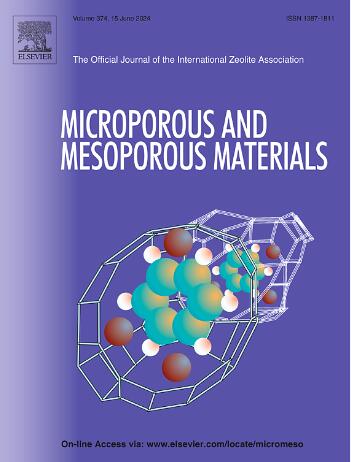Shedding electrons on ADOR zeolite structures – Structure determination by 3DED
IF 4.8
3区 材料科学
Q1 CHEMISTRY, APPLIED
引用次数: 0
Abstract
Three-dimensional electron diffraction (3DED) offers a powerful alternative to single-crystal X-ray diffraction (SCXRD) for the structure determination of crystalline materials with small-sized crystals (usually nanometre-sized) or crystals with intergrowths, often produced during zeolite synthesis. ADOR is a synthesis strategy of novel daughter zeolites from well-known parent germanosilicates. Structure determination of such ADOR zeolites is challenging due to the presence of aggregated intergrowths, and often small-sized crystals. This work demonstrates the application of continuous rotation electron diffraction (cRED), a type of 3DED, for the rapid structural characterisation of zeolites produced by ADOR approach. cRED can be performed in a transmission electron microscope and the structure of a studied material can be obtained rapidly. We propose a unified workflow for the structure determination of ADOR daughter materials. This workflow involves the initial structural investigation and determination of the parent material, followed by the utilization of this knowledge to facilitate the subsequent structure determination of the daughter material. Investigation strategy was shown to be uniform, as presented for ADOR transformation of two different parent germanosilicates. This approach is a tool allowing prompt recognition of new ADOR zeolites at the early stage of their synthesis and can be used for a feedback-based optimisation of synthesis conditions.

求助全文
约1分钟内获得全文
求助全文
来源期刊

Microporous and Mesoporous Materials
化学-材料科学:综合
CiteScore
10.70
自引率
5.80%
发文量
649
审稿时长
26 days
期刊介绍:
Microporous and Mesoporous Materials covers novel and significant aspects of porous solids classified as either microporous (pore size up to 2 nm) or mesoporous (pore size 2 to 50 nm). The porosity should have a specific impact on the material properties or application. Typical examples are zeolites and zeolite-like materials, pillared materials, clathrasils and clathrates, carbon molecular sieves, ordered mesoporous materials, organic/inorganic porous hybrid materials, or porous metal oxides. Both natural and synthetic porous materials are within the scope of the journal.
Topics which are particularly of interest include:
All aspects of natural microporous and mesoporous solids
The synthesis of crystalline or amorphous porous materials
The physico-chemical characterization of microporous and mesoporous solids, especially spectroscopic and microscopic
The modification of microporous and mesoporous solids, for example by ion exchange or solid-state reactions
All topics related to diffusion of mobile species in the pores of microporous and mesoporous materials
Adsorption (and other separation techniques) using microporous or mesoporous adsorbents
Catalysis by microporous and mesoporous materials
Host/guest interactions
Theoretical chemistry and modelling of host/guest interactions
All topics related to the application of microporous and mesoporous materials in industrial catalysis, separation technology, environmental protection, electrochemistry, membranes, sensors, optical devices, etc.
 求助内容:
求助内容: 应助结果提醒方式:
应助结果提醒方式:


